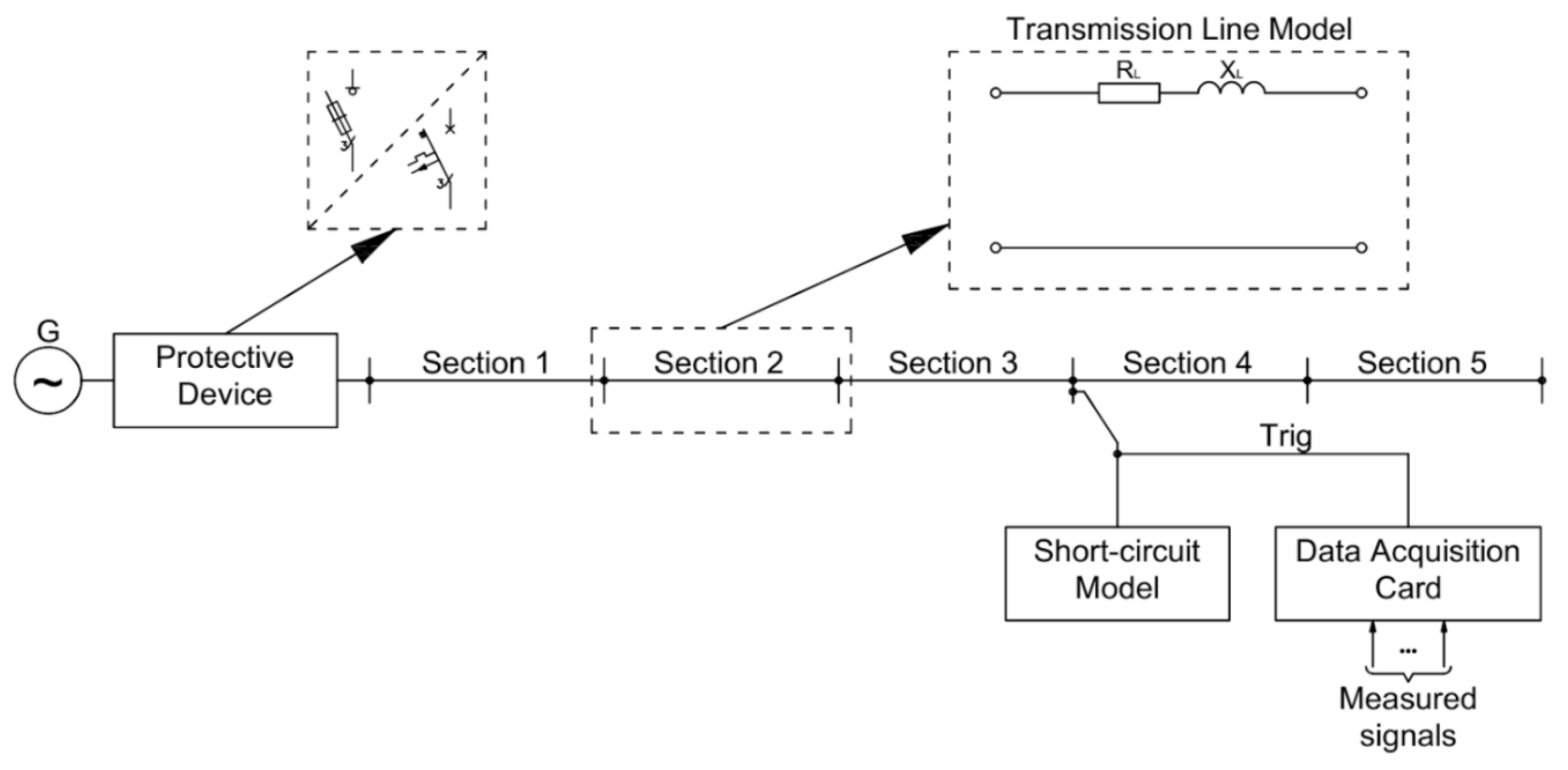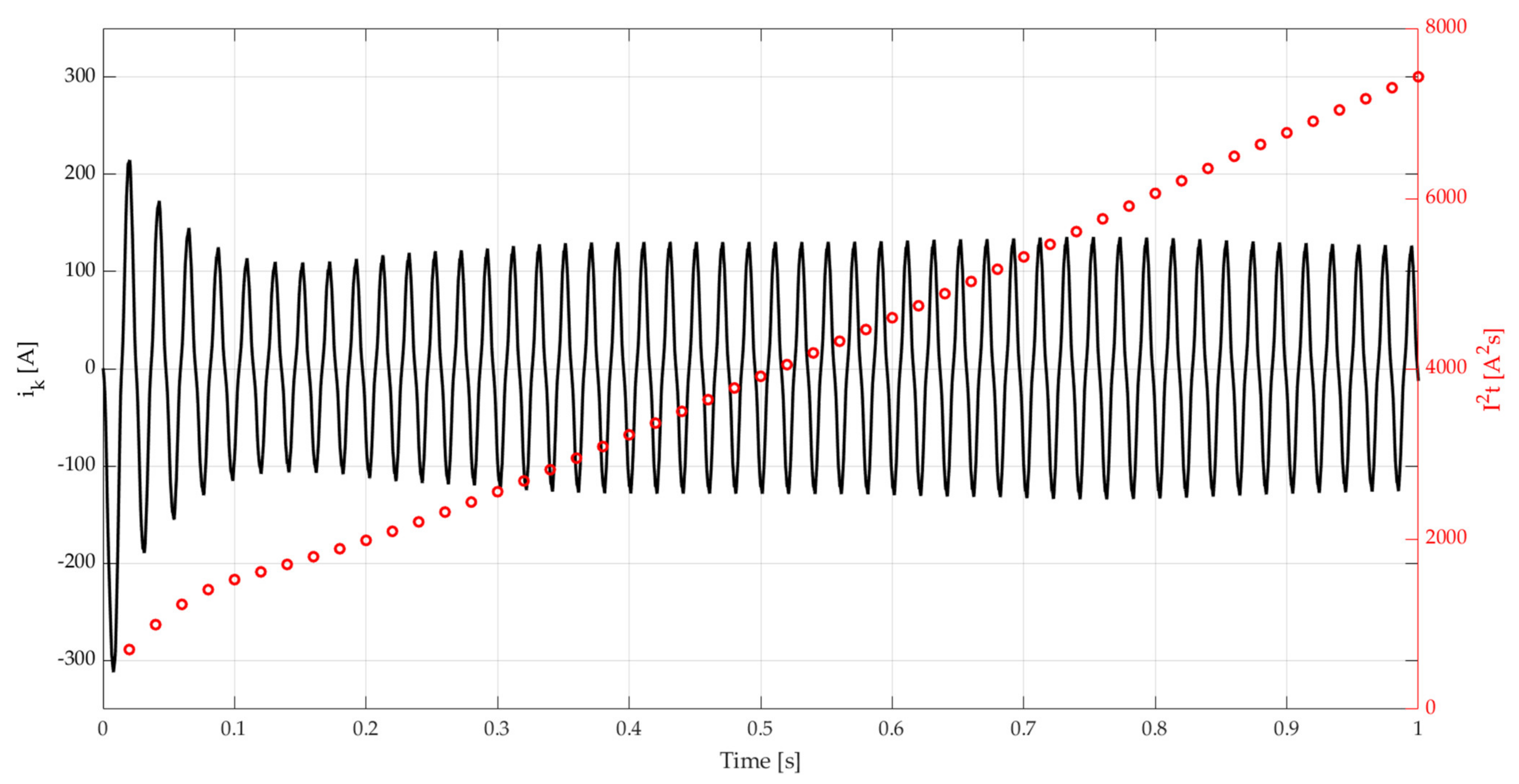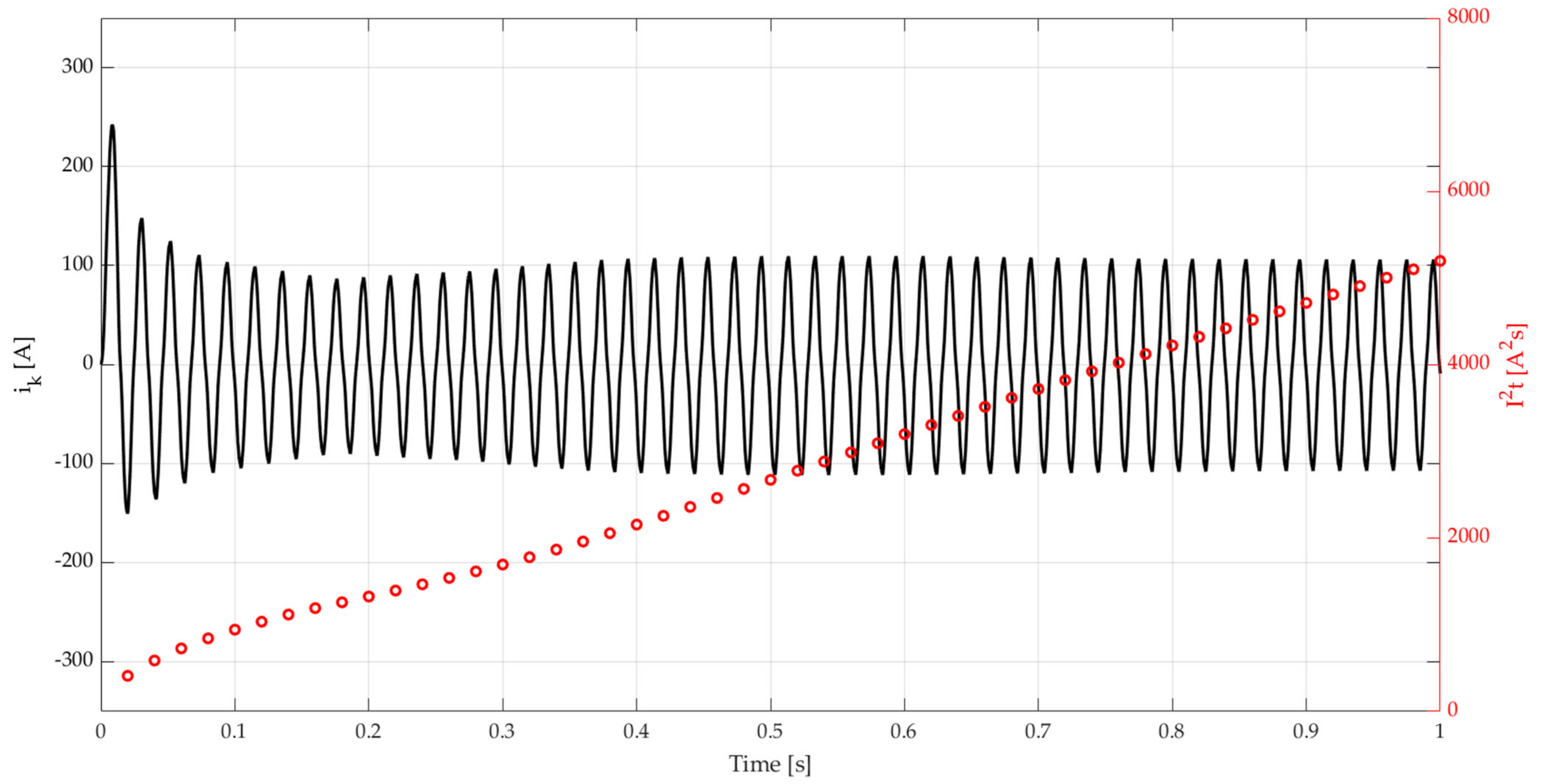The Short-Circuit Protections in Hybrid Systems with Low-Power Synchronous Generators
Abstract
1. Introduction
2. The Overcurrent Protection Devices
- —short-circuit switch-off time [s],
- —time from short-circuit start to electric arc appearance [s],
- —short-circuit current value [A].
3. The Statistic of Short-Circuit Types and the Characteristic of Silent Poles Synchronous Generators
3.1. The Short-Circuit Types Participation
3.2. The Characteristic of Low-Power Silent Poles Synchronous Generators
- —maximum phase voltage value,
- —direct axis synchronous reactance,
- —direct axis transient reactance,
- —direct axis sub-transient reactance,
- —quadrature axis sub-transient reactance,
- —phase shift angle,
- —aperiodic time constant [s].
- —direct axis short-circuit transient time constant [s],
- —direct axis short-circuit sub-transient time constant [s],
- —direct axis transient inductance [H],
- —direct axis sub-transient inductance [H],
- —armature resistance [Ω].
4. The Laboratory System
4.1. Description of the Measurement System
4.2. Experimental Work
5. Conclusions
Author Contributions
Funding
Data Availability Statement
Conflicts of Interest
References
- Drozdowski, P.; Warzecha, A. Mathematical Study and Control of Diesel Rotary Uninterruptible Power Supply. In Proceedings of the 2019 15th Selected Issues of Electrical Engineering and Electronics (WZEE), Zakopane, Poland, 8–10 December 2019; pp. 469–475. [Google Scholar] [CrossRef]
- Best, R.J.; Morrow, D.J.; McGowan, D.J.; Crossley, P.A. Synchronous islanded operation of a diesel generator. IEEE Trans. Power Syst. 2007, 22, 2170–2176. [Google Scholar] [CrossRef]
- Regulation of the Minister for Infrastructure and Construction Amending the Regulation of the Minister for Infrastructure of 12 April 2002 on the Technical Conditions to Be Met by Buildings and Their Location, Dz.U. 2002 nr 75 poz. 690. Available online: http://isap.sejm.gov.pl/isap.nsf/download.xsp/WDU20020750690/O/D20020690.pdf (accessed on 15 June 2002).
- IEEE Std 30045-2014. Recommended Practice for the Application of Low-Voltage Circuit Breakers in Industrial and Commercial Power Systems; IEEE: New York, NY, USA, 21 August 2014. [Google Scholar]
- IEC 60909-0:2016. Short-Circuit Currents in Three-Phase a.c. Systems–Part 0: Calculation of Currents, 28 January 2016.
- Wiatr, J. Generating Sets in Emergency Power Supply Systems for Buildings. In Notebooks for Electricians–no 3 Series; Publishing House Medium: Warsaw, Poland, 2009. [Google Scholar]
- Ludwinek, K.; Szczepanik, J.; Sułowicz, M. Experimental analysis of assessing of the tripping effectiveness of miniature circuit breakers in an electrical installation fed from a synchronous generator set. Electr. Power Syst. Res. 2017, 142, 341–350. [Google Scholar] [CrossRef]
- Kozmian, R.; Kusz, A.; Kuna-Broniowski, M.; Makarski, P.; Scibisz, M.; Ludwinek, K.; Nadolski, R.; Staszak, J. Assessing of the Tripping Effectiveness of Fuses in Electrical Installation Fed from a Synchronous Generator Set. In Proceedings of the 2015 Selected Problems of Electrical Engineering and Electronics (WZEE), Kielce, Poland, 17–19 September 2015; pp. 1–4. [Google Scholar] [CrossRef]
- Albrechtowicz, P.; Szczepanik, J. The analysis of the effectiveness of standard protection devices in supply systems fed from synchronous generator sets. In Proceedings of the 2018 International Symposium on Electrical Machines (SME): SME 2018, Andrychów, Poland, 10–13 June 2018; pp. 1–5. [Google Scholar] [CrossRef]
- Gautam, V.P.; Joseph, F.C. Evaluation of Short Circuit Currents in Networks with Low Voltage Ride Through (LVRT) Enabled Voltage Source Converters (VSC) based Wind Turbines. In Proceedings of the 2018 20th National Power Systems Conference (NPSC), Tiruchirappalli, India, 14–16 December 2018; pp. 1–6. [Google Scholar] [CrossRef]
- Gopalan, S.; Sreeram, V.; Iu, H.; Mishra, Y. An Improved Protection Strategy for Microgrids. In Proceedings of the IEEE PES ISGT Europe 2013, Lyngby, Denmark, 6–9 October 2013; pp. 1–5. [Google Scholar] [CrossRef]
- Sahoo, A.K. Protection of microgrid through coordinated directional over-current relays. In Proceedings of the 2014 IEEE Global Humanitarian Technology Conference–South Asia Satellite (GHTC-SAS), Trivandrum, India, 26–27 September 2014; pp. 129–134. [Google Scholar] [CrossRef]
- Sahebkar Farkhani, J.; Zareein, M.; Najafi, A.; Melicio, R.; Rodrigues, E.M.G. The power system and microgrid protection—A Review. Appl. Sci. 2020, 10, 8271. [Google Scholar] [CrossRef]
- Rozegnał, B.; Albrechtowicz, P.; Mamcarz, D. The protections of the 5-node medium voltage power system in case of the symmetrical faults. In Proceedings of the 2019 15th Selected Issues of Electrical Engineering and Electronics, WZEE 2019, Zakopane, Poland, 8–10 December 2019. [Google Scholar] [CrossRef]
- Gordon, P. Developments from the R&D Community: Control and Protection of Diesel Gen-Sets; The Institution of Electrical Engineers: Savoy Place, London, UK, 1998; pp. 6/1–6/5. [Google Scholar]
- Meng, Q.; Li, S.; Jiao, Z. A Cut-off protection circuit based on dynamic arc recognition and termination technology. Electr. Eng. 2019, 20, 23–27. [Google Scholar]
- Gong, H.; Zong, M. Study on the new structure and its influencing factors of miniature circuit breaker for short circuit protection. In Seventh International Conference on Electronics and Information Engineering; IEEE: New York, NY, USA, 2017. [Google Scholar] [CrossRef]
- Chen, L.; Chen, Y.; Ding, Q. Selective Switch with Selective Protective Module. Patent Number CN1617405A, 3 December 2004. [Google Scholar]
- Popczyk, J. Present and Expected Short-Circuit Current Values in Electrical Power Systems; Energetyka: Warsaw, Poland, 1986; pp. 6–10. (In Polish) [Google Scholar]
- Kanicki, A. The Symmetrical Component Method Used to Modeling Transient States of Electrical Power System; Tom Z349; Wydawnictwo Politechniki Łódzkiej: Wólczańska, Poland, 2006; pp. 3–176. [Google Scholar]
- Mamcarz, D.; Albrechtowicz, P.; Radwan-Pragłowska, N.; Rozegnał, B. The Analysis of the Symmetrical Short-Circuit Currents in Backup Power Supply Systems with Low-Power Synchronous Generators. Energies 2020, 13, 4474. [Google Scholar] [CrossRef]
- Latek, W. The Theory of Electrical Machines; WNT: Warszawa, Poland, 1987. (In Polish) [Google Scholar]
- Kacejko, P.; Machowski, J. Short Circuits in the Electroenergetic System; WNT: Warszawa, Poland, 2020. (In Polish) [Google Scholar]
- Linz Electric Generators. Available online: https://www.linzelectric.com/index.cfm/en/products/ (accessed on 6 July 2020).
- Das, J.C. Short-Circuits in AC and DC Systems: ANSI, IEEE and IEC Standards; Taylor & Francis Inc.: Portland, OR, USA, 2017. [Google Scholar]
- Chiver, O.; Neamt, L.; Matei, O. Comparative study on sudden short-circuit currents of a synchronous generator. In Proceedings of the 2015 IEEE 15th International Conference on Environment and Electrical Engineering (EEEIC), Rome, Italy, 10–13 June 2015; pp. 1688–1693. [Google Scholar] [CrossRef]
- Ludwinek, K. Measurement of Momentary Currents by Hall Linear Sensor. Prz. Elektrotech. 2009, 85, 182–187. [Google Scholar]
- Ocłoń, P.; Pobędza, J.; Walczak, P.; Cisek, P.; Vallati, A. Experimental Validation of a Heat Transfer Model in Underground Power Cable Systems. Energies 2020, 13, 1747. [Google Scholar] [CrossRef]
- Proton Polska–Commercial Offer. Available online: https://proton-polska.pl/product-pol-497-Agregat-pradotworczy-Proton-Oasis-3.html (accessed on 20 November 2020).
- ETI Fuses Catalogue. Available online: https://www.etigroup.eu/images/userfiles/en-GB/documents/products/building_industry/BIE_digital_2019.pdf (accessed on 21 September 2020).







| Rated phase voltage, [V] | |||
| Maximal permissible off-switching time, t [s] | 0.8 | 0.4 | 0.2 |
| [kVA] | 11 | 11.5 | 13.5 | 16 | 22 | 27 |
| Number of poles | 2 | 2 | 2 | 2 | 2 | 2 |
| [%] | 280 | 239 | 275 | 382 | 373 | 350 |
| [%] | 21 | 19 | 22 | 26 | 29 | 31 |
| [%] | 5.8 | 4.6 | 5.3 | 10 | 12 | 11 |
| [%] | 155 | 130 | 150 | 166 | 162 | 152 |
| [kVA] | 7 | 10 | 13.5 | 16 | 22 | 27 | |||
| [ms] | 33 | 33 | 46 | 41 | 47 | 54 | 830 | 850 | 1210 |
| [ms] | 5.5 | 6 | 5.9 | 6 | 6 | 7 | 23 | 28 | 30 |
| The Number of Section | |||
|---|---|---|---|
| Generator | 340 | 124 | 7913 |
| First section | 312 | 129 | 7431 |
| Second section | 257 | 115 | 6116 |
| Third section | 241 | 105 | 5196 |
| Fourth section | 214 | 98 | 4497 |
| Fifth section | 200 | 93 | 4283 |
| The Place of Short-Circuit | Generator [ms] | 1st Section [ms] | 2nd Section [ms] | 3rd Section [ms] | 4th Section [ms] | 5th Section [ms] | |
|---|---|---|---|---|---|---|---|
| The Protective Device Type | |||||||
| gG10A | 10 | 10 | 10 | 10 | 10 | 340 | |
| gG16A | 10 | 10 | 100 | 650 | D.N.R. | D.N.R. | |
| gG20A | D.N.R. | D.N.R. | D.N.R. | D.N.R. | D.N.R. | D.N.R. | |
| gG25A | D.N.R. | D.N.R. | D.N.R. | D.N.R. | D.N.R. | D.N.R. | |
| C16A | 10 | 10 | 10 | 10 | 10 | 10 | |
| C20A | 10 | 10 | 10 | 10 | D.N.R. | D.N.R. | |
| C25A | D.N.R. | D.N.R. | D.N.R. | D.N.R. | D.N.R. | D.N.R. | |
| B16A | 10 | 10 | 10 | 10 | 10 | 10 | |
| B20A | 10 | 10 | 10 | 10 | 10 | 10 | |
| B25A | 10 | 10 | 10 | 10 | 10 | 10 | |
Publisher’s Note: MDPI stays neutral with regard to jurisdictional claims in published maps and institutional affiliations. |
© 2020 by the authors. Licensee MDPI, Basel, Switzerland. This article is an open access article distributed under the terms and conditions of the Creative Commons Attribution (CC BY) license (http://creativecommons.org/licenses/by/4.0/).
Share and Cite
Rozegnał, B.; Albrechtowicz, P.; Mamcarz, D.; Radwan-Pragłowska, N.; Cebula, A. The Short-Circuit Protections in Hybrid Systems with Low-Power Synchronous Generators. Energies 2021, 14, 160. https://doi.org/10.3390/en14010160
Rozegnał B, Albrechtowicz P, Mamcarz D, Radwan-Pragłowska N, Cebula A. The Short-Circuit Protections in Hybrid Systems with Low-Power Synchronous Generators. Energies. 2021; 14(1):160. https://doi.org/10.3390/en14010160
Chicago/Turabian StyleRozegnał, Bartosz, Paweł Albrechtowicz, Dominik Mamcarz, Natalia Radwan-Pragłowska, and Artur Cebula. 2021. "The Short-Circuit Protections in Hybrid Systems with Low-Power Synchronous Generators" Energies 14, no. 1: 160. https://doi.org/10.3390/en14010160
APA StyleRozegnał, B., Albrechtowicz, P., Mamcarz, D., Radwan-Pragłowska, N., & Cebula, A. (2021). The Short-Circuit Protections in Hybrid Systems with Low-Power Synchronous Generators. Energies, 14(1), 160. https://doi.org/10.3390/en14010160






